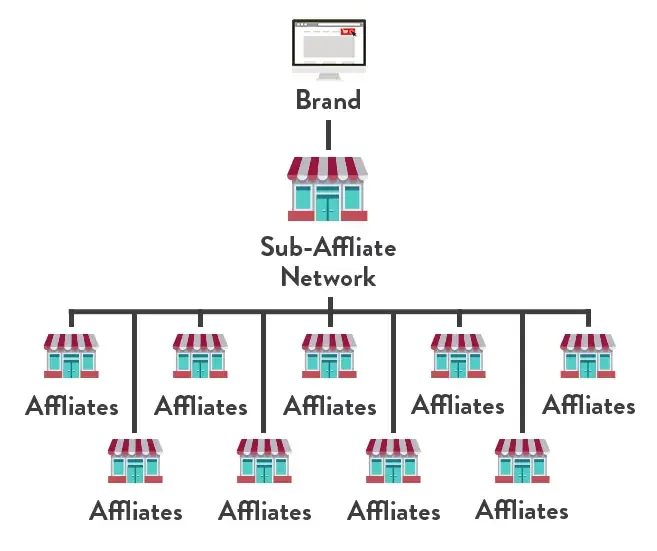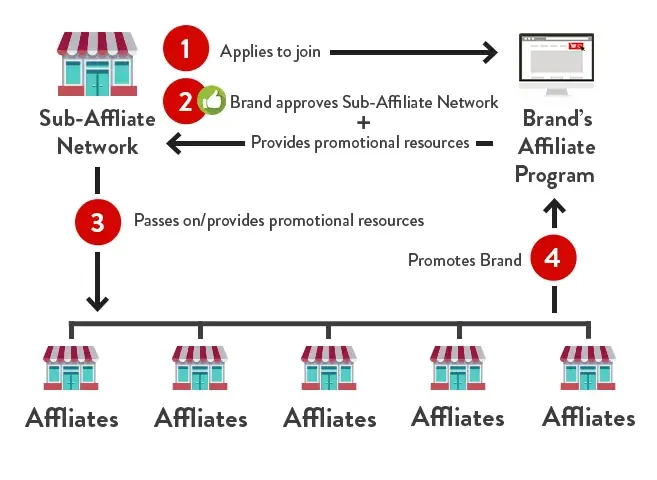August 30, 2024

Did you know the affiliate marketing industry is worth more than $17 billion annually? Experts expect it to grow even more by 2027, reaching a staggering $27.78 billion. Roughly 60% of brands have incorporated some amount of affiliate marketing into their digital portfolio — but what about sub-affiliates?
Sub-affiliates work with both your brand and a network of their own affiliates. Like any partner within the affiliate marketing ecosystem, sub-affiliate networks help brands promote their products and services efficiently and cost-effectively.
What’s a bit different between a sub-affiliate network and other types of affiliate partners is how brands work with them.
Understanding Sub-Affiliate Networks
A sub-affiliate acts as a type of “go-between” for your brand and a larger, established network of affiliates — known as a sub-affiliate network.
At its simplest, a sub-affiliate will apply to partner with your brand as an affiliate. If accepted, they will share your objectives, creatives and any other relevant information with their own network of affiliates. This network may include a variety of content creators, influencers, blog and website owners and third-party review or voucher sites.
Take a closer look at the process:
- A sub-affiliate network applies to join a brand’s affiliate program via an affiliate network or platform.
- Once accepted into the program, the sub-affiliate network receives promotional details, creative and messaging from the brand.
- The sub-affiliate network then provides those resources to the affiliates within their platform so they have the information and tools they need to promote the brand.
The sub-affiliate network will then work to promote your brand and earn commissions on conversions.
How Do Sub-Affiliate Networks Work?
Sub-affiliate network marketing is a type of affiliate marketing. However, a sub-affiliate network can be a way to scale your efforts without additional effort or investment, offering services and support to both brands and affiliates — often content creators, bloggers, influencers, website owners or bloggers (“sub-affiliates”) — and helps them monetize their blog, website or social channel on a cost-per-action (CPA) basis.
Sub-affiliate networks help simplify this process by acting as the affiliate of record — or the main, approved affiliate — within a brand’s affiliate program and providing the centralized link building, communications, reporting and payments to the sub-affiliates on their platform.

Sub-Affiliate Networks in Action
Affiliates can make use of the sub-affiliate network’s internally generated HTML or Javascript code to monetize different keywords on their site. When the code is placed on the website, specific brand keywords would automatically convert into a tracked affiliate link. This allows the publisher to make a commission if a user clicks on the affiliate link to make a purchase without having to manually input affiliate links into the pages of their site.

Benefits of Sub-Affiliate Networks
Partnering with sub-affiliate networks has numerous benefits, including easy scalability and a relatively low investment of time, money and energy.
Other advantages may include:
- Efficient, effective growth: In many cases, sub-affiliate networks offer brands an efficient and effective way to grow and scale their programs quickly.
- Access to a large network of affiliate partners: Through sub-affiliate networks, brands can gain access to a wide range of content partners; for many brands, these partners are a major point of interest and key to their promotional strategies.
- Larger ROI: The scale of sub-affiliate networks can drive significant traffic, sales and revenue for brands — without requiring a substantial upfront investment.
- Less time spent developing an affiliate partner network: Brands can easily share their offers with hundreds (even thousands) of affiliates without having to form direct relationships with them.
- Shorter time to launch: Because sub-affiliate networks typically comprise established, seasoned content partners, brands can enjoy nearly immediate campaign launches.
- Convenient reporting: Generally speaking, the sub-affiliate will be your single source of performance data and conversions reporting — not each individual affiliate. That means you can easily monitor your campaign in one convenient location.
Choosing the Right Sub-Affiliate Network
It’s critical to vet your sub-affiliate and their affiliate network before signing on. It can also be helpful to work with a trusted partner like Acceleration Partners. Our team of experts works with brands to manage affiliate and sub-affiliate campaigns and ensure quality control following launch.
Transparency into the sub-affiliate network’s roster and their methods for driving traffic is essential, too. Remember: These affiliates are representing your brand. Make sure that the practices, platforms and messages shared align with your vision for your product or service.
Sub-Affiliate Implementation Strategies
To ensure a successful relationship with a sub-affiliate network, brands and their affiliate program management team need to do their due diligence and research on the sub-affiliate network prior to partnering.
Here are some best practices brands should keep in mind when navigating and optimizing partnerships with sub-affiliate networks:
- Communication: Before partnering with a sub-affiliate network through your affiliate program (or even multiple sub-affiliate networks), it’s essential to clearly communicate what types of affiliate partners you are open to promoting your products/service and those you’d prefer to restrict. If the sub-affiliate network does not allow for this, then they may not be the right partner for your affiliate program.
- Quality expectations: If you have expectations around the quality of traffic that you want driven to your site via the affiliates within a sub-affiliate network, those expectations – and the key performance indicators you intend to use to measure that quality – should be addressed prior to partnering.
- Transparency: Be vigilant about working only with sub-affiliate networks that are transparent and will provide clear visibility into which affiliates on their platform are driving traffic and how – especially if through referring URLs. This information should be made available via the affiliate network/platform or via readily-available reporting.
- Compliance: The sub-affiliate network must ensure that the affiliates on their platform adhere to the brand’s terms and conditions. This includes, but is not limited to: restrictions on software/browser extensions commission terms, restricted promotional methods and paid placements, such as a pay-per-click campaigns.
- Fraud prevention: It’s important to ensure that your sub-affiliate network partner will promptly remove any affiliates that are engaging in fraudulent activity or not properly following your terms and conditions.
- Regular updates: To ensure consistency throughout all your marketing channels, keep your sub-affiliate network notified of any creative changes or upcoming promotions.
- Monitor performance: Keep an eye on your campaign performance and monitor conversion data for opportunities to streamline and optimize your campaign.
Common Challenges and How to Overcome Them
In general, sub-affiliate network marketing is a relatively low-effort, low-risk way to expand your brand’s reach and grow access to trusted affiliate partners. However, there are a few drawbacks to consider.
For example, it’s important to maintain a level of quality. Your affiliates don’t necessarily need professional-grade content or websites, but, with a large network, it may be difficult to ensure promoted content achieves a standard you’re comfortable with.
In addition, be aware of your margins. When working with a traditional affiliate, the commission is generally split two ways: between your brand and the partner. However, with a sub-affiliate network, commissions may be split further. As a result, a sub-affiliate partner may request a larger split to ensure they and their affiliate network members receive a larger payout.
Sub-Affiliate Network FAQs
Still learning about sub-affiliate networks? Read on for some answers to frequently asked questions.
How are sub-affiliate networks — and their affiliates — paid?
When a sub-affiliate drives a desired conversion/outcome for the brand, the sub-affiliate network is compensated by the brand.
The sub-affiliate network then passes a significant percentage of that compensation on to the sub-affiliate who contributed to those conversions.

Different sub-affiliate networks take a different portion of sales, so it’s important for brands and affiliates alike to understand the commission split prior to partnering. Some sub-affiliate networks are able to adjust commission payouts to the sub-affiliates on their platform according to the brand’s commission structure.
For example, if a brand has structured their commission compensation so that coupon partners are paid 6%, loyalty partners are paid 8% and content partners are paid 10%, the sub-affiliate network can structure their payouts to the affiliates on their network who are promoting that brand in a similar way (while also keeping a portion of the commission payout themselves).
Why do affiliates join sub-affiliate networks?
Many bloggers, influencers and website owners want to monetize their content but don’t always have the resources or knowledge of how to manage their affiliate business on their own.
Their focus is on creating valuable content and effectively promoting the brand (as it should be) rather than figuring out how to join numerous affiliate networks, apply for the programs they’re interested in, pull links and creative and manage relationships with multiple brands.
Working via sub-affiliate network can alleviate those complexities for affiliates and help them – and the brands they promote – quickly and efficiently scale their business.
Most sub-affiliate networks also offer individualized support to help the affiliates within their network navigate the affiliate channel, handle service requests and optimize their promotional efforts with brands.
Source from accelerationpartners.com
Disclaimer: The information set forth above is provided by accelerationpartners.com independently of Alibaba.com. Alibaba.com makes no representation and warranties as to the quality and reliability of the seller and products. Alibaba.com expressly disclaims any liability for breaches pertaining to the copyright of content.




